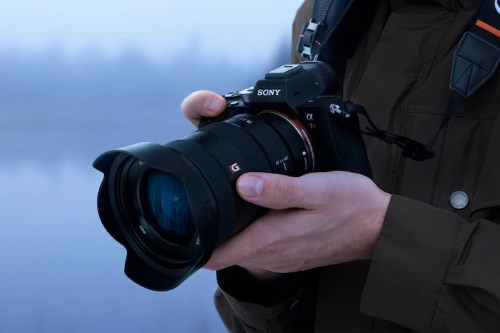
Mirrorless cameras may have finally nudged the DSLR off the top spot — the best-selling full-frame camera in the U.S. is now a mirrorless model. On August 15, Sony shared data that puts it as the top-selling brand for full-frame cameras for the first-half of 2018 in the United States.
Sony slid into that top spot in both dollar amount and the number of cameras sold during the first-half of 2018 in the U.S, according to data from the NPD Group, a company that tracks retail sales. During that time, four out of every 10 full-frame cameras sold carried the Sony name, the company says. Sony’s new status comes as the company maintains the top spot for the most sold mirrorless cameras overall for more than six years.
The new sales statistics come as the industry sits on the precipice of what could be a major shift. With Nikon expected to announce a new full-frame mirrorless on August 23, Sony and Leica will no longer be the only brands offering a full-frame sensor inside a mirrorless camera. Rumors suggest Canon is thinking of doing the same, but the DSLR giant has yet to confirm the existence of a full-frame mirrorless.
Sony’s full-frame mirrorless cameras were generally well-received from the start, but the company says it was the third-generation models, the A7R III and A7 III, that propelled sales to that top position, along with the speed-focused A9. The company’s full-frame interchangeable lens cameras grew by 78 percent from 2017. While increasing speed and performance, the third generation in the series also addressed some of the user feedback on the larger sensor mirrorless format, including a significant increase in battery life. (While Sony has SLR-like models like the A77 II, those use an APS-C sensor).
While Canon and Nikon have historically held the spots for the best-selling professional cameras, industry analysts like Scott Peterson at Gap Intelligence suggest that it’s because Sony wasn’t at the top for DSLRs that the company was able to innovate in the mirrorless category.
“Sony has established a lot of clout and the big reason why is they had nothing to lose,” Peterson said. “They didn’t have noteworthy SLRs to drain from so they’ve been shooting for the moon, better, higher, faster.”
Sony’s Alpha series led the company to take the second spot for full-frame cameras in 2017. Those numbers aren’t without shift, however — Nikon said the D850 lead the company to the top spot for full-frame sales for the month of December 2017.
Sony is celebrating the growth with a “Be Alpha” campaign, which includes events throughout 2018, including a campaign launching on World Photo Day, August 19, in New York City. The campaign also encourages creators to use the hashtag #BeAlpha.
“We’re extremely proud of achieving number-one overall share in full-frame cameras in the US market, as well as holding a strong No. 1 share in the mirrorless market for six years running,” Neal Manowitz, vice president of Digital Imaging at Sony Electronics, said in a press release. “More than anything, we owe this to our community. It is our pleasure to create for you, the true creators. You pushed us to innovate, to change, to continually adapt, and your voice remains core to everything we do.”
Additional details on the campaign are available at www.alphauniverse.com.
Editors' Recommendations
- The best travel cameras
- The best mirrorless cameras
- The Nikon Z 7 II and Z 6 II are coming October 14: Here’s what we want to see
- Sony teases ‘new concept’ Alpha series camera set to launch next week
- Sony teases the more approachable FX6 cinema camera